Trials performed at Hagerman Fish Culture Experiment Station in Idaho
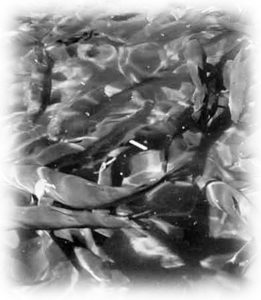 Carnivorous fish like rainbow trout (Oncorhynchus mykiss) are traditionally fed diets containing large amounts of fishmeal. Global fishmeal production is not growing and demand for fishmeal may eventually exceed annual production, especially during El Niño years. To avoid this scenario, alternative protein sources such as plant protein meals are being substituted for portions of fishmeal.
Carnivorous fish like rainbow trout (Oncorhynchus mykiss) are traditionally fed diets containing large amounts of fishmeal. Global fishmeal production is not growing and demand for fishmeal may eventually exceed annual production, especially during El Niño years. To avoid this scenario, alternative protein sources such as plant protein meals are being substituted for portions of fishmeal.
Advantages of plant protein meals
There are two advantages to using plant protein meals. They are usually less expensive and lower in phosphorus content than fishmeal. Excessive nutrient discharges at fish farms – especially of phosphorus and nitrogen – can lead to eutrophication of the receiving water.
Aquafeeds are the source of this phosphorus and nitrogen, so the manipulation of diet formulations such that amino acids and phosphorus levels meet but do not exceed the dietary requirements of fish is an efficient way to reduce environmental pollution associated with raceway or cage culture.
Lysine supplementation
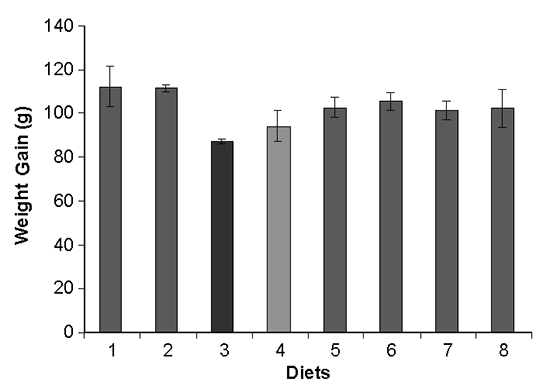
However, plant protein substitution for fishmeal is usually limited by the lysine level in the final feed, because most plant protein meals are deficient in lysine compared to fishmeal. Thus, supplementing lysine and other essential amino acids, if necessary, in plant protein-based fish diets formulated with low phosphorus levels is one way to reduce diet cost and the amount of phosphorus discharged into the aquatic environment.
During 2001 and 2002, the authors conducted two trials to evaluate the effects on trout performance of supplemental lysine in plant protein meal-based diets, and total ammonia nitrogen (TAN) and soluble phosphorus excretion. Both trials were performed at the Hagerman Fish Culture Experiment Station of the University of Idaho in Hagerman, Idaho, USA.
Experimental diets fish rearing
Trial 1 involved eight diets (Table 1), each fed to triplicate tanks of fish. Diet 1 was a fishmeal-based reference diet formulated to contain 42 percent dietary crude protein (CP) and 2.1 percent synthetic lysine. Diet 2 was another fishmeal-based reference diet containing 2.1 percent lysine, but only 37 percent CP. The basal diet (diet 3) used plant protein meals to replace 50 percent of the fishmeal. It was formulated to contain 37 percent dietary CP and 1.5 percent lysine. The other five diets had 37 percent CP and 1.65, 1.8, 1.95, 2.1, and 2.25 percent dietary lysine.
Cheng, Diet formulation and chemical analysis, Table 1
| Ingredient | Diet 1 | Diet 2 | Diet 3 | Diet 4 | Diet 5 | Diet 6 | Diet 7 | Diet 8 |
|---|
Ingredient | Diet 1 | Diet 2 | Diet 3 | Diet 4 | Diet 5 | Diet 6 | Diet 7 | Diet 8 |
|---|---|---|---|---|---|---|---|---|
| Herring meal | 32.8 | 32.8 | 16.4 | 16.4 | 16.4 | 16.4 | 16.4 | 16.4 |
| Soybean meal | 0 | 3.4 | 8.4 | 8.3 | 8.3 | 8.5 | 8.7 | 9.0 |
| Whole wheat | 26.1 | 31.93 | 28.92 | 29.1 | 29.2 | 29.23 | 29.44 | 29.23 |
| Fish oil | 15.2 | 17.5 | 18.58 | 18.56 | 18.54 | 18.52 | 18.5 | 18.58 |
| Corn gluten meal | 13.5 | 5.68 | 11.7 | 11.5 | 11.5 | 11.49 | 11.48 | 11.44 |
| Wheat gluten | 10.0 | 6.0 | 13.0 | 12.92 | 12.64 | 12.23 | 11.64 | 11.3 |
| L-Lysine-HCl, purity 98.5% | 0 | 0 | 0 | 0.2 | 0.4 | 0.6 | 0.8 | 1.0 |
| Other ingredients | 2.4 | 2.69 | 3.00 | 3.02 | 3.02 | 3.03 | 3.04 | 3.05 |
| Analyzed Composition | ||||||||
| Moisture | 6.6 | 6.7 | 6.3 | 6.6 | 6.5 | 6.6 | 6.3 | 6.1 |
| Crude protein | 42.4 | 36.7 | 36.8 | 37.0 | 36.8 | 36.4 | 36.2 | 36.2 |
| Crude fat | 19.0 | 21.4 | 21.8 | 21.6 | 21.3 | 21.7 | 21.5 | 21.7 |
| Phosphorus | 0.9 | 0.9 | 0.6 | 0.6 | 0.6 | 0.6 | 0.6 | 0.6 |
| Lysine | 2.1 | 2.0 | 1.56 | 1.64 | 1.83 | 1.96 | 2.1 | 2.23 |
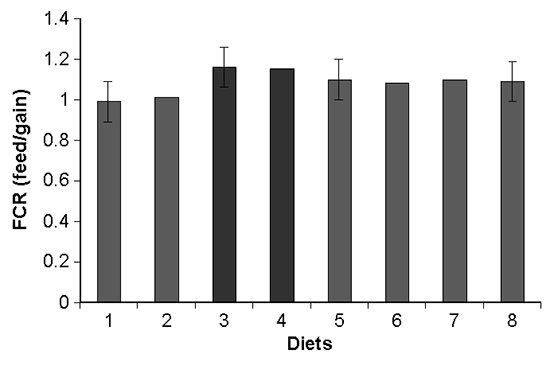
The analyzed values were close to expected values. Diets 2-8 were formulated to be isonitrogenous and all diets were isocaloric. Replacing fishmeal with plant protein meals in diets 3-8 reduced dietary phosphorus levels from 0.9 to 0.6 percent, which is the reported requirement for trout.
Rainbow trout of average body weight 26.9 ± 0.2 g) were randomly selected and placed into 24, 140-l fiberglass tanks at 50 fish/tank. The fish were fed 3 times/day every day to apparent satiation for eight weeks.
After trial 1 was completed, the remaining fish were used to measure TAN and soluble phosphorus excretion in trial 2. Fish were fed their respective diets for one week, and water samples were then taken for TAN and soluble phosphorus analyses. The procedures were repeated next day. All sample values were measured and expressed on a 140-l tank and 130 fish/tank basis.
Results: trial 1
Trial 1 results for weight gain and feed-conversion ratio (FCR) are presented in Figs. 1 and 2, respectively. Fish fed the fishmeal-based diet 2 containing 37 percent CP grew as fast as those fed the diet containing 42 percent CP (diet 1). Fish fed plant protein-based diets with lysine supplementation at 0.4 percent and higher maintained growth performance despite a reduction in dietary CP level from 42 to 37 percent. FCR followed a pattern similar to weight gain, except that fish fed lysine-supplemented diets did not show significant improvement over fish fed basal diet 2.
Results: trial 2
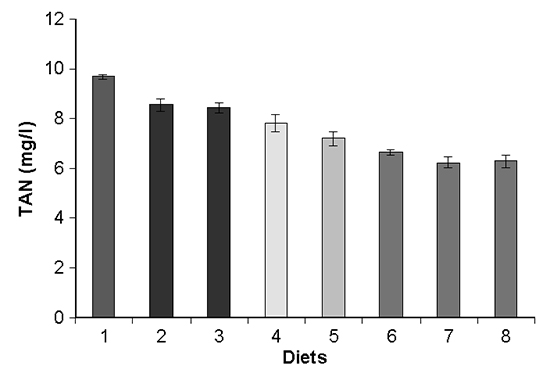
Figs. 3 and 4 show the discharge values for TAN and soluble phosphorus. Fish fed diet 1 produced more TAN and soluble phosphorus than those fed diet 2, indicating higher discharges of TAN and soluble phosphorus at higher dietary CP levels.
Fish fed diet 2 discharged more TAN and soluble phosphorus than those fed the plant protein-based diet 7, even when their dietary CP and lysine levels were formulated to be equal, showing that protein sources play a role in TAN and soluble phosphorus discharges. Fish fed lysine-supplemented diets discharged less TAN and soluble phosphorus than fish fed the basal diet, demonstrating that lysine supplementation reduced such discharges.
Conclusion
Results of this study showed that rainbow trout fed plant protein-based diets supplemented with lysine at 0.4 percent or higher grew as well as those fed fishmeal-based diets. Lysine supplementation reduced TAN discharges in plant protein-base diets, presumably by balancing the intake of essential amino acids and thus lowering the amount of assimilated protein metabolized for energy rather than building muscle and other tissues. The discharge of soluble phosphorus was significantly reduced when dietary phosphorus levels were reduced from 0.9 percent to 0.6 percent, indicating the retention of phosphorus can be increased by lowering dietary phosphorus level.
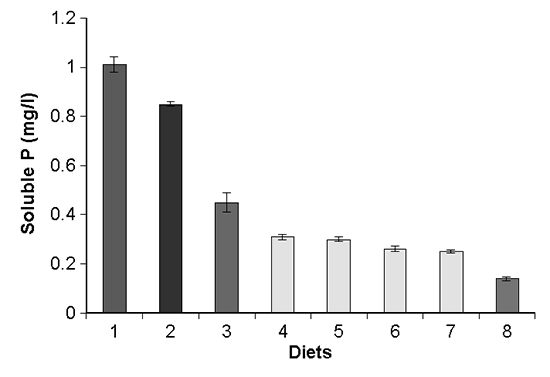
(Editor’s Note: This article was originally published in the April 2003 print edition of the Global Aquaculture Advocate.)
Now that you've finished reading the article ...
… we hope you’ll consider supporting our mission to document the evolution of the global aquaculture industry and share our vast network of contributors’ expansive knowledge every week.
By becoming a Global Seafood Alliance member, you’re ensuring that all of the pre-competitive work we do through member benefits, resources and events can continue. Individual membership costs just $50 a year. GSA individual and corporate members receive complimentary access to a series of GOAL virtual events beginning in April. Join now.
Not a GSA member? Join us.
Authors
-
Zongjia J. Cheng, Ph.D.
Hagerman Fish Culture Experiment Station
University of Idaho
3059 F National Fish Hatchery Road
Hagerman, Idaho 83332 USA -
Ronald W. Hardy, Ph.D.
Hagerman Fish Culture Experiment Station
University of Idaho
3059 F National Fish Hatchery Road
Hagerman, Idaho 83332 USA
Tagged With
Related Posts

Health & Welfare
Cathepsin enzymes, part 2
Cathepsin D alone and in combination with other cathepsins presents the greatest proteolytic activity on some fish muscles.

Health & Welfare
Killing methods, post-slaughter quality, part 3
Slaughter methods can impact product quality. It is recommended that fish be fasted prior to slaughter to clean their digestive tracts. Instant killing minimizes the degradation of tissue quality. Immediate bleeding is more important than the bleeding method.

Health & Welfare
Off-flavors in salmonids raised in RAS
The presence of compounds such as geosmin and 2-methylisoborneol (MIB) in recirculating aquaculture systems (RAS) can result in earthy or musty off-flavors in salmonids raised in the systems.

Aquafeeds
Feeds affect lipid body composition, quality
The substitution of plant proteins and oils for fishmeal and fish oil can result in minimal changes to proximate compositions in various fish. However, the muscle fatty acid composition usually reflects that of the diet.


